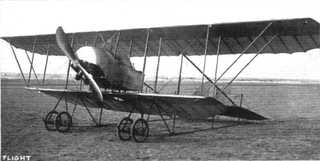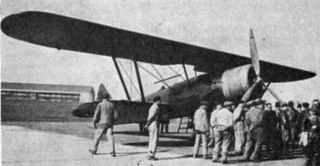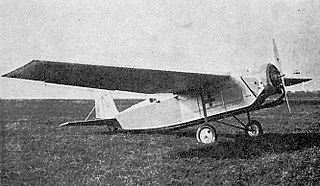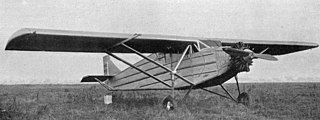
The Caudron C.109 was a light utility aircraft built in France in the late 1920s.

The Pander E was the first indigenous Dutch training aircraft, used by clubs and also privately owned. A two-seat, single-engine biplane, 17 were built in the Netherlands from 1926 with engines of increasing power.
The Caudron C.251 Et-2 was a French tandem seat, open cockpit biplane designed as an intermediate trainer and built in 1931. It did not go into production.
The Caudron C.220 was a two-seat French biplane trainer. Only two were built, using different engines.

The Caudron C.27 was a French biplane, a two-seat basic trainer which also competed successfully in the 1920s.

The Caudron C.101 and its variants, the C.103, C.104 and C.107 were French two seat reconnaissance aircraft flown from 1925, differing in their engines.

The Caudron C.67 was a simple single seat biplane with a low powered engine. It was built and flown in France in 1922.
The Caudron Type B was a 1911 development of the earliest Caudron type, the Caudron Type A, with a nacelle style fuselage and more powerful engine. Initially an equal span biplane, it was modified into a sesquiplane.

The Caudron Type F was a French single seat biplane produced just before World War I. A dozen were bought by China and at least two other examples, with different engines, competed in 1913, coming first and second in the biplane category of the cross-country race at Reims. Flown by Pierre Chanteloup, one was the first biplane to loop-the-loop.

The Albert TE.1 was a single seat cantilever parasol wing monoplane, wood framed and skinned and built in France in 1926. It made some notable long flights, set a French altitude record for its class and proved a practical light aircraft.

The Delanne 11 was a French two seat touring aircraft. Only one was built.
The Romano R.16 was a three engine, high wing monoplane designed for policing and other rôles in France's African colonies.

The Potez 50 or Potez 50 A2 was a French two seat military multi-rôle aircraft, first flown in 1931. It did not go into service but seven variants using five different engines were produced, one of them setting several speed with useful load records and another, the Potez 506, setting three altitude world records.
The Caudron C.580 was a French advanced trainer aircraft intended to prepare pilots for the new low wing monoplane fighters of the mid-1930s. It did not go into production and only two were built.
The Duverne-Saran 01 was a twin engine, three seat touring aircraft built in France in the mid-1930s. Only one was completed.
The Caudron C.570 was a French twin-engine aircraft designed and built by Caudron in the mid-1930s. It was designed to function in multiple roles; as a bomber, passenger transport, paratroop aircraft, cargo aircraft and air ambulance.

The Guillemin JG.40 was designed and built to meet a French government requirement for a small air ambulance capable of operating in the colonies. Two were completed and performed well but the JG.40 did not reach production.
The Poite 3 was a one-off, all metal touring aircraft which seated two in tandem. It was built and flown in France in 1931.

The Aviaméta 92 was a French, all-metal, five seat monoplane built in the late 1920s. Three different engines were fitted, and one example flew the first non-stop Paris-Algiers flight in preparation for an abandoned trans-Atlantic attempt.

The Couzinet 30 was a light transport aircraft / mailplane designed and built in France in 1930 at Société des Avions René Couzinet.














